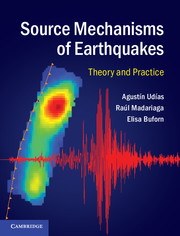Book contents
- Frontmatter
- Contents
- Preface
- Chapter 1 Earthquakes and fault motion
- Chapter 2 Processing and analysis of recorded seismic signals
- Chapter 3 Mathematical representation of the source
- Chapter 4 Point source models
- Chapter 5 The seismic moment tensor
- Chapter 6 Determination of point source mechanisms
- Chapter 7 Kinematics of extended sources
- Chapter 8 Determination of source dimensions
- Chapter 9 Simple dynamic models
- Chapter 10 Dynamics of fracture. Homogeneous models
- Chapter 11 Fracture dynamics. Heterogeneous models
- Chapter 12 Modeling earthquakes using fracture dynamics
- References
- Index
Chapter 12 - Modeling earthquakes using fracture dynamics
Published online by Cambridge University Press: 05 June 2014
- Frontmatter
- Contents
- Preface
- Chapter 1 Earthquakes and fault motion
- Chapter 2 Processing and analysis of recorded seismic signals
- Chapter 3 Mathematical representation of the source
- Chapter 4 Point source models
- Chapter 5 The seismic moment tensor
- Chapter 6 Determination of point source mechanisms
- Chapter 7 Kinematics of extended sources
- Chapter 8 Determination of source dimensions
- Chapter 9 Simple dynamic models
- Chapter 10 Dynamics of fracture. Homogeneous models
- Chapter 11 Fracture dynamics. Heterogeneous models
- Chapter 12 Modeling earthquakes using fracture dynamics
- References
- Index
Summary
Dynamic models
The theory of the dynamic fracture process at an earthquake source was presented in Chapters 9 to 11. This theory is the basis for the development of methods for the study of earthquake dynamics. Kinematic models, as we have seen, describe the source of an earthquake in terms of the space–time distribution of slip on a certain fault surface. Dynamic models relate the slip to the stresses acting on the fault. Thus, the source is described in terms of the distribution of stress and friction and the elastic properties of the material. Kinematic inversion methods are at present routinely applied to study sufficiently large earthquakes (MW > 5.5) using strong motion, regional and teleseismic data. Dynamic models are significantly more involved and can be applied only to recent earthquakes that have been well recorded in the near field by strong motion data. For example, such studies have been applied to the earthquakes of Landers (1992), Kobe (1995), Chi Chi (1999), Izmit (1999) and Tottori (2000).
Earthquakes are three-dimensional phenomena that are very complex to model because of the interplay of the two fracture modes Mode II (in-plane) and Mode III (antiplane) and the presence of singularities near the border of the fault. There seems to be no way to obtain analytical solutions for shear rupture propagation in three dimensions, so that even for the simplest problems we have to resort to numerical simulation. A wide range of numerical methods is available including finite difference methods in three dimensions (Harris and Day, 1993; Mikumo and Miyatake, 1995; Madariaga et al., 1998; Cruz-Atienza and Virieux, 2004), as well as finite element techniques (Duan and Oglesby, 2006; Ma et al., 2008; Duan, 2010), high-order spectral element techniques (Kaneko et al., 2010) and unstructured discontinuous element methods (Tago et al., 2012). Advanced numerical methods together with the availability of fast parallel computers have opened the way to the study of accurate dynamic rupture models.
- Type
- Chapter
- Information
- Source Mechanisms of EarthquakesTheory and Practice, pp. 259 - 283Publisher: Cambridge University PressPrint publication year: 2014



